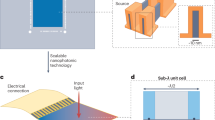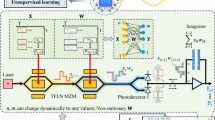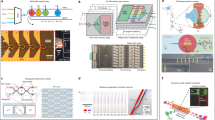Abstract
Propelled by advancements in artificial intelligence, the demand for field-programmable devices has grown rapidly in the last decade. Among various state-of-the-art platforms, programmable integrated photonics emerges as a promising candidate, offering a new strategy to drastically enhance computational power for data-intensive tasks. However, intrinsic weak nonlinear responses of dielectric materials have limited traditional photonic programmability to the linear domain, leaving out the most common and complex activation functions used in artificial intelligence. Here we push the capabilities of photonic field-programmability into the nonlinear realm by meticulous spatial control of distributed carrier excitations and their dynamics within an active semiconductor. Leveraging the architecture of photonic nonlinear computing through polynomial building blocks, our field-programmable photonic nonlinear microprocessor demonstrates in situ training of photonic polynomial networks with dynamically reconfigured nonlinear connections. Our results offer a new paradigm to revolutionize photonic reconfigurable computing, enabling the handling of intricate tasks using a polynomial network with unparalleled simplicity and efficiency.
This is a preview of subscription content, access via your institution
Access options
Access Nature and 54 other Nature Portfolio journals
Get Nature+, our best-value online-access subscription
$32.99 / 30 days
cancel any time
Subscribe to this journal
Receive 12 print issues and online access
$259.00 per year
only $21.58 per issue
Buy this article
- Purchase on SpringerLink
- Instant access to full article PDF
Prices may be subject to local taxes which are calculated during checkout





Similar content being viewed by others
Data availability
The main data that support this study are available within the Article and its Supplementary Information. The additional raw and processed data are available at https://doi.org/10.6084/m9.figshare.28560848.v1.
Code availability
The computer codes that support the plots within this paper and other findings of this study are available from the corresponding author on reasonable request.
References
Compton, K. & Hauck, S. Reconfigurable computing: a survey of systems and software. ACM Comput. Surv. 34, 171–210 (2002).
Bondalapati, K. & Prasanna, V. K. Reconfigurable computing systems. Proc. IEEE 90, 1201–1217 (2002).
Reagen, B. et al. Minerva: enabling low-power, highly-accurate deep neural network accelerators. In 2016 ACM/IEEE 43rd Annual International Symposium on Computer Architecture (ISCA) 267–278 (ACM/IEEE, 2016).
Chen, Y.-H., Krishna, T., Emer, J. S. & Sze, V. Eyeriss: an energy-efficient reconfigurable accelerator for deep convolutional neural networks. IEEE J. Solid-State Circuits 52, 127–138 (2017).
Bogaerts, W. et al. Programmable photonic circuits. Nature 586, 207–216 (2020).
Wang, J., Sciarrino, F., Laing, A. & Thompson, M. G. Integrated photonic quantum technologies. Nat. Photon. 14, 273–284 (2019).
Shen, Y. et al. Deep learning with coherent nanophotonic circuits. Nat. Photon. 11, 441–446 (2017).
Liu, W. et al. A fully reconfigurable photonic integrated signal processor. Nat. Photon. 10, 190–195 (2016).
Pai, S. et al. Experimentally realized in situ backpropagation for deep learning in photonic neural networks. Science 380, 398–404 (2023).
Feldmann, J. et al. Parallel convolutional processing using an integrated photonic tensor core. Nature 589, 52–58 (2021).
Shastri, B. J. et al. Photonics for artificial intelligence and neuromorphic computing. Nat. Photon. 15, 102–114 (2021).
Ashtiani, F., Geers, A. J. & Aflatouni, F. An on-chip photonic deep neural network for image classification. Nature 606, 501–506 (2022).
Ying, Z. et al. Electronic-photonic arithmetic logic unit for high-speed computing. Nat. Commun. 11, 2154 (2020).
Xu, Z. et al. Large-scale photonic chiplet Taichi empowers 160-TOPS/W artificial general intelligence. Science 384, 202–209 (2024).
Pérez-López, D., López, A., DasMahapatra, P. & Capmany, J. Multipurpose self-configuration of programmable photonic circuits. Nat. Commun. 11, 6359 (2020).
Feldmann, J., Youngblood, N., Wright, C. D., Bhaskaran, H. & Pernice, W. H. P. All-optical spiking neurosynaptic networks with self-learning capabilities. Nature 569, 208–214 (2019).
Wang, T. et al. An optical neural network using less than 1 photon per multiplication. Nat. Commun. 13, 123 (2022).
Sludds, A. et al. Delocalized photonic deep learning on the internet’s edge. Science 378, 270–276 (2022).
Lin, X. et al. All-optical machine learning using diffractive deep neural networks. Science 361, 1004–1008 (2018).
Zhou, H. et al. Photonic matrix multiplication lights up photonic accelerator and beyond. Light: Sci. Appl. 11, 30 (2022).
Camacho, M., Edwards, B. & Engheta, N. A single inverse-designed photonic structure that performs parallel computing. Nat. Commun. 12, 1466 (2021).
Wanjura, C. C. & Marquardt, F. Fully non-linear neuromorphic computing with linear wave scattering. Nat. Phys. 20, 1434–1440 (2024).
Xia, F. et al. Nonlinear optical encoding enabled by recurrent linear scattering. Nat. Photon. 18, 1067–1075 (2024).
Yildirim, M., Dinç, N. U., Oguz, I., Psaltis, D. & Moser, C. Nonlinear processing with linear optics. Nat. Photon. 18, 1076–1082 (2024).
Dubovitsky, S., Steier, W. H., Mathur, A. & Dapkus, P. D. Gain saturation properties of a semiconductor gain medium with tensile and compressive strain quantum wells. IEEE J. Quantum Electron. 30, 380–391 (1994).
Haiml, M., Grange, R. & Keller, U. Optical characterization of semiconductor saturable absorbers. Appl. Phys. B 79, 331–339 (2004).
Zhao, H. et al. Non-Hermitian topological light steering. Science 365, 1163–1166 (2019).
Zhang, Z. et al. Spin-orbit microlaser emitting in a four-dimensional Hilbert space. Nature 612, 246–251 (2022).
Qiao, X. et al. Higher-dimensional supersymmetric microlaser arrays. Science 372, 403–408 (2021).
Zhang, Z. et al. Tunable topological charge vortex microlaser. Science 368, 760–763 (2020).
Zhang, Y. et al. High-dimensional quantum key distribution by a spin–orbit microlaser. Phys. Rev. X. 15, 011024 (2025).
Chrysos, G. G. et al. Deep polynomial neural networks. IEEE Trans. Pattern Anal. Mach. Intell. 44, 4021–4034 (2022).
Chrysos, G. G. et al. P–nets: Deep polynomial neural networks. In 2020 IEEE/CVF Conference on Computer Vision and Pattern Recognition (CVPR) 7325–7335 (IEEE, 2020).
Wu, T., Menarini, M., Gao, Z. & Feng, L. Lithography-free reconfigurable integrated photonic processor. Nat. Photon. 17, 710–716 (2023).
Nair, V. & Hinton, G. E. Rectified linear units improve restricted boltzmann machines. In Proc. 27th International Conference on International Conference on Machine Learning 807–814 (Omnipress, 2010).
Feng, X. et al. Non-Hermitian hybrid silicon photonic switching. Nat. Photon. 19, 264–270 (2025).
Fisher, R. Iris (UCI Machine Learning Repository, 1936); https://doi.org/10.24432/C56C76
Warden, P. Speech Commands: A Public Dataset for Single-Word Speech Recognition (2017); https://storage.googleapis.com/download.tensorflow.org/data/speech_commands_v0.01.tar.gz
Lenton, I. C. D., Stilgoe, A. B., Nieminen, T. A. & Rubinsztein-Dunlop, H. OTSLM toolbox for structured light methods. Comput. Phys. Commun. 253, 107199 (2020).
Acknowledgements
We acknowledge the support from Defense Advanced Research Projects Agency (DARPA) (grant no. W911NF-21-1-0340), Office of Naval Research (ONR) (grant no. N00014-23-1-2882) and National Science Foundation (NSF) (grant nos. ECCS-2023780, ECCS-2425529 and DMR-2326699). L.G. acknowledges the support from the National Science Foundation (NSF) (grant nos. PHYS-1847240 and DMR-2326698).
Author information
Authors and Affiliations
Contributions
T.W. and L.F. conceived the project. T.W. developed the in situ training algorithm for nonlinear networks, fabricated the devices, and performed optical measurements and digital network simulations. Y.L., T.W. and L.G. developed theoretical models for nonlinear photonic transmission. L.F. guided the research. All authors participated in discussions and contributed to the writing of the paper.
Corresponding author
Ethics declarations
Competing interests
The authors declare no competing interests.
Peer review
Peer review information
Nature Photonics thanks Fei Xia and Jianping Yao for their contribution to the peer review of this work.
Additional information
Publisher’s note Springer Nature remains neutral with regard to jurisdictional claims in published maps and institutional affiliations.
Extended data
Extended Data Fig. 1 Optical measurement.
a, Set-up for the measurement. VA: variable attenuator; OBJ: objective; DM: dichroic mirror; BPF: band-pass filter. b, An image captured by the camera, with the influence of the PL removed by subtracting a reference image taken without input signals. The white dashed boxes on the left indicate the integration area for input port powers, while the yellow dashed boxes on the right highlight the integration area for output port powers. c, Calibration of the digital readout of the camera, performed using a large external laser light spot that covers most of the camera’s working area. The results show a convincing linear input–output power response within the working range.
Supplementary information
Supplementary Information
Supplementary Figs. 1–12 and Tables 1–5.
Rights and permissions
Springer Nature or its licensor (e.g. a society or other partner) holds exclusive rights to this article under a publishing agreement with the author(s) or other rightsholder(s); author self-archiving of the accepted manuscript version of this article is solely governed by the terms of such publishing agreement and applicable law.
About this article
Cite this article
Wu, T., Li, Y., Ge, L. et al. Field-programmable photonic nonlinearity. Nat. Photon. 19, 725–732 (2025). https://doi.org/10.1038/s41566-025-01660-x
Received:
Accepted:
Published:
Issue date:
DOI: https://doi.org/10.1038/s41566-025-01660-x
This article is cited by
-
On-chip programmable nonlinearity
Nature Photonics (2025)



